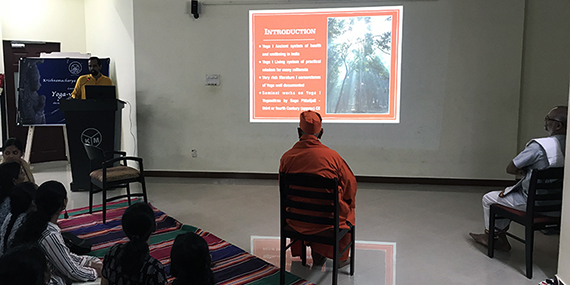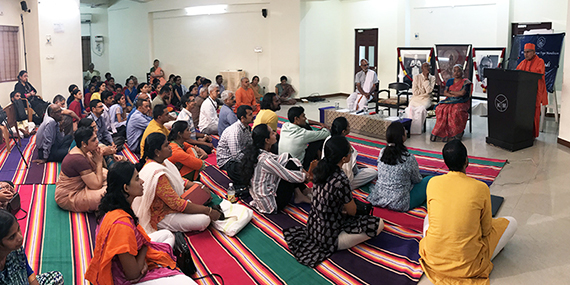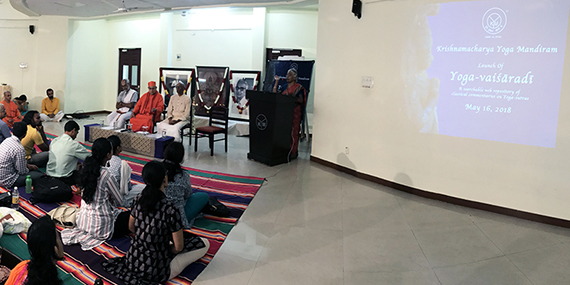
Yoga-vaiśāradī is a web application that is developed with an objective to facilitate easy access to the classical commentaries of Yogasūtras of Sage Patañjali. Vaiśāradī means an expert. This web-based tool is designed to facilitate expertise and scholarship in the field of Yoga Philosophy.
A SHORT VIDEO ON HOW TO USE THE TOOL
LAUNCH VIDEO OF YOGA-VAIŚĀRADĪ
UNIQUE FEATURES
- This is one of the most comprehensive resource on classical commentaries to Yogasūtras on the world wide web. It covers commentary literature to Yogasūtras from the 3rd Century CE to 19th Century CE – i.e 1600 Years of Content on Yogasūtras.
- All the content is in Unicode and hence they can be viewed and utilized by scholars, students and teachers across all platforms.
- The content can be read or transliterated into five Major scripts namely – Devanagari, Roman, Bengali, Tamil and Kannada – to cater to worldwide and countrywide audience.
- There is a search facility where Yogic terms can be searched as per hierarchy – source texts, commentaries, sub-commentaries (in both Devanagari and Roman scripts).
COMMENTARIES OF YOGASŪTRAS
 14 Sanskrit commentaries to the Yogasūtras have been digitized as part of this project. They can be classified into two types.
14 Sanskrit commentaries to the Yogasūtras have been digitized as part of this project. They can be classified into two types.
- Vyāsa’s commentary and it sub-commentaries – Phase One
- Sanskrit commentaries that are independent of Vyāsa’s commentary – Phase Two.
PHASE ONE
Vyāsa’s commentary is considered the closest to the period of Yogasūtras (3rd or 4th Century CE) and hence it is respected as primary commentary. There are four known sub-commentaries to Vyāsa’s commentary to Yogasūtra.
- Tattvavaiśāradī of Vācaspati Miśra (9th or 10th century)
- Vivaraṇa of Śaṅkara (13th Century – not settled with finality)
- Vārttika of Vijñānabhikṣu (15th Century)
- Bhāsvatī of Hariharānanda Āraṇya (19th century)
A sub commentary to Tattvavaiśāradī– Pātañjalarahasya by Rāghavānanda sarasvatī (1550-1600) has also been digitized as part of this phase.
Along with these classical commentaries, the first chapter of Yogavallī, a Sanskrit commentary to the Yogasūtras by yogācārya Śrī T Krishnamacharya (20th Century) is provided.
The views of Sri TKV Desikachar, son and student of Sri T Krishnamacharya on Yogasūtras in English – titled Reflections to Yogasūtras is also presented.
Also, Complete Tamil translation of Sage Vyāsa’s commentary of Yogasūtras by Dr.M.Jayaraman has also been included as part of this phase.
Thus currently the first phase of Yoga-vaiśāradī has Six Sanskrit commentaries of Yogasūtras (and one English commentary and one Tamil Translation).
PHASE TWO
This phase has added Eight independent classical Sanskrit Commentaries to Yogasūtras. They have been presented chronologically below:

- Rājamārtāṇḍa by Bhojadeva (1000 CE)
- Maṇiprabhā by Rāmānanda yati (1550-1600 CE)
- Pradīpikā by Bhāvagaṇeśa (1600 – 1700 CE)
- Yogasiddhāntacandrikā by Nārāyaṇatīrtha (1700-1750 CE)
- Sutrārthabodhinī by Nārāyaṇatīrtha(1700-1750 CE)
- Vṛtti by Nāgojibhaṭṭa (1700 – 1750 CE)
- Yogasudhākara by sadaśivendra sarasvatī (1700-1800 CE)
- Yogacandrikā anantadevapaṇḍita (1800 – 1900 CE)
OTHER YOGA TEXTS
Along with the above commentary texts, to facilitate cross-referencing of Yogic concepts few other important Yoga/ Sāṅkhya texts form part of the repository which are also searchable. They include:
- Haṭhayogapradīpikā of svātmārāma (15th Century)
- with Jyotsnā commentary by Brahmānanda (19th Century)
- Bhagavadgītā only mūlaślokas
Gheraṇḍasaṃhitā, Yogayājñavalkyasaṃhitā & sāṅkhyakārikā īśvarakṛṣṇa (to be included)
NOTE
Sanskrit commentaries are very detailed. Care has been taken to keep the content error-free. But some inadvertent typographical errors might have crept in. We seek the support of users/readers to point out those mistakes so that we can perfect this in due course. You may write to yoga-vaisaradi@kym.org. The web-repository Yoga Vaishararadi can be accessed at www.kymyogavaisharadi.org.
